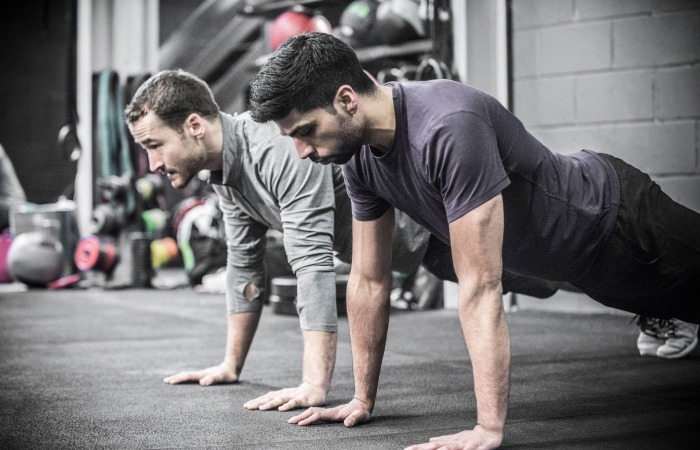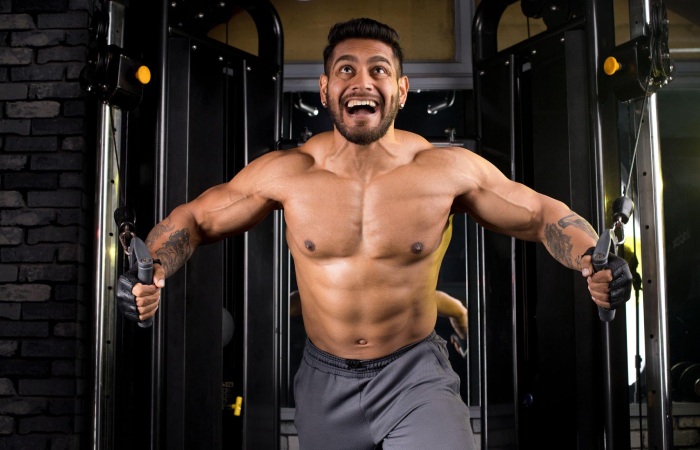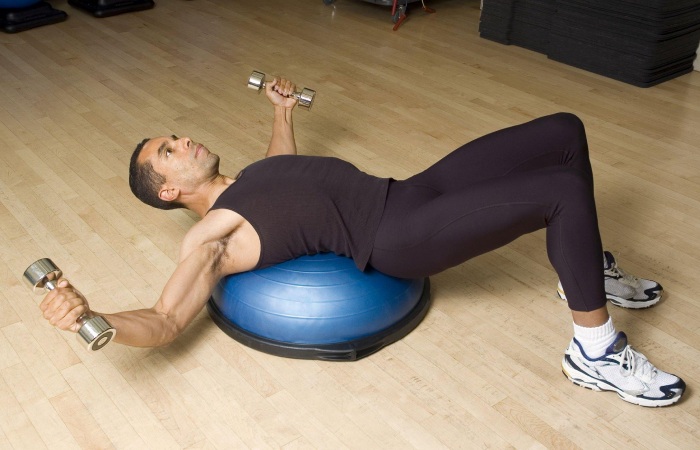Inner Chest Workout – The term “chest” refers to the pectoralis major, sometimes known as the pecs. It is a sizable muscle with a fan-like structure that extends horizontally from the rib cage’s middle to the arm’s humerus bone. Two muscle heads, commonly known as the upper and lower chest, make up the chest (pec major). Together, these muscle heads may push and rotate in actions like the bench press. But to better comprehend this.
Table of Contents
The Anatomy of The Chest (Inner Chest Workout)
Sternocostal head: The lower chest is also known as the sternocostal head. The inner chest house in this muscle is the most noticeable of the pecs. This head begins at the sternum and extends outward horizontally to the humerus. The sternal head propels most arm rotation and adduction (think hugging motions). Technically, the area of this head that is situated closer to the sternum and center of your chest is the inner chest. The finest chest exercises, including the flat bench press and fly, are also the best for developing the entire chest; however, more on later.
Clavicular head: The “upper chest,” or clavicular head. It goes downhill from the clavicle, where it is attached, to the humerus. It is the minor head of the pec major, accounting for around 20% of the mass of the entire chest (inner chest workout). Although it supports the lower chest, the clavicular head is more responsible for arm flexion (lifting the arm upward). Therefore, you may work the upper chest by performing incline presses and other cable fly variations.
Minor pectoralis: This little muscle locates underneath the pec major. Just below the collarbone, it joins the upper ribs to the upper front section of the shoulder blade. The shoulder blade’s stability and rotational movements are the pec minor’s primary roles. Although it is involved in almost all chest exercises, this role is primarily supporting. So, it’s impossible to isolate this muscle. However, activities that drive the shoulder blades downward, such as dips and decline presses, can help you boost its activation.
Serratus Anterior: Although it is not a part of the chest, the serratus anterior helps to shape and function the chest (inner chest workout). It comprises finger-like muscles that rise from your ribs and travel up the sides of your body to your shoulder blades. The serratus helps to move the arms forward or overhead by pulling the shoulder blades forward and along the rear of the rib cage. Dumbbell pullovers, for example, work the serratus and aid in expanding the chest.
Training The Inner Chest Workout
Before we get into the best Workouts for the inner chest, there are a few things to consider when exercising the chest.
Rep Range & Volume: Your goals typically dictate the rep ranges of your workouts. Hypertrophy is typically associated with higher rep ranges (8–15). Stick to higher reps if you’re attempting to gain muscle or lose chest fat. Pure strength gains typically require lower rep ranges (1–5). Having stated that, a range of rep ranges is necessary for muscular development.
Note: The ideal rep range for achieving hypertrophy is frequently unclear. In addition to repetitions, time spent under tension and the kind of muscle also plays a role in muscular development. For instance, short reps and high weights don’t work well on smaller muscles like the biceps and deltoid muscles. Although it’s not a strict rule, following this advice will help you avoid injuries and keep your workouts effective.
Grip posture is crucial for the bench press, another divisive subject. It’s ideal for keeping your arms slightly broader than shoulder width for developing your entire chest. Change to a tighter grasp to highlight the inner chest workout. The triceps play a significant role in this grip as well. If you use this grip, you must release the weight.
The dispute between barbells and dumbbells is an age-old one. There are minor distinctions, but overall, both equally contribute to the growth and activation of the chest muscles. Because dumbbells distribute the pressure over nearby muscles for stabilization and an overall better range of motion, you can press heavier weights with the barbell. Again, the perfect workout will combine the two. The barbell is the best tool for consistent growth of the inner chest workout.
Progressive Overload is the idea of building up resistance throughout sets and sessions. Although you can increase the weight from set to set, do it gradually to preserve the rep range. Remember that the exercises above should perform with 10-15 repetitions, nearly to failure for each set. Once you can complete a set without difficulty, it’s time to add weight.
Progressive Overload takes weight and additional factors into account, including time under tension, downtime, time to failure, and more. You can combine techniques, but try not to overdo it in one cycle.
Best Exercises For The Inner Chest Workout
Close Grip Push-Up ( (Inner Chest Workout)

The push-up is at the top of our list since it serves as the basis for developing the chest (inner. The finest push-up for the inner chest performs with a close grip. While it won’t produce gains comparable to free weights, it will teach you proper form, give you a strong foundation, and allow you to perform the exercise anywhere. How many push-ups you are unable to perform can surprise you.
How To Do Close-Grip Push-Ups:
- Assume the push-up position, but place your hands about 2″ apart; you can squat or rest by lowering your knees to the ground.
- Lower your chest a few ins above your hands while maintaining a straight back.
- You can raise your chest back up to the starting position by tightening your triceps and inner chest.
Bench Press
The best free-weight workout for developing the entire chest is the bench press. It exerts significant pressure on the sternal head, which is ideal for the inner chest. Even while the bench press doesn’t immediately affect the inner chest, it helps build the strength needed for workouts that do. If you use dumbbells instead of weights and the floor instead of a bench, you can also incorporate this exercise into a chest workout at home.
How to do bench presses:
- Put your hands slightly wider than shoulder-width apart, palms facing front, and wrap your thumb around the bar as you recline on a flat bench on your back.
- Do not allow the bar to touch your chest as you carefully descend it from the rack, stopping about 3 to 4 inches from the center of your chest.
- To move the bar back to the initial position, tighten your chest.
- At the end of the set, repeat, and rerack.
Cable Fly

The finest exercises for concentrating stress in the inner chest workout are flies. Constant tension from cable exercises keeps the muscle stimulated throughout its entire range of motion. Finally, you can experiment with a number of exercises using the cable machine that might benefit your routine.
How to do cable flys:
- Set up: Choose the weight, then lower the cable handles to about shoulder width. Step forward while standing in the middle of the rack with your arms drawn back but slightly bent forward at the elbows.
- Begin by keeping your arms bent and squeezing them together. The inside of the pecs needs to be squeezed with a lot of effort.
- When your hands come together in front of you, stop, but keep your pecs tense.
- You’ll still feel a little stretch when you slowly bring your arms back to your sides.
Dumbbell Fly

The dumbbell fly is a fundamental exercise that everyone should be able to complete. The dumbbell fly uses arm rotation to effectively strike the inside chest (inner chest workout). Remember that you’ll be fighting gravity in this one. This exercise is part of our back and chest routine because it significantly increases pec size!
How to do dumbbell flys:
- Get comfortable on the bench by placing your feet firmly on the ground, keeping your shoulders close to the surface, and lying back while holding the weights close to your chest.
- Hold this position and push the arms together over the chest in a wide arc. • Extend your arms outward with elbows pointed downward and lower arms angled slightly up toward the sky.
- As the weights come together at the top of the lift, tension will peak, so make sure to keep the tension up the entire time.
- When the elbows are almost below the bench, cease lowering the weights back toward the floor.
Svend Press
Similar to the hex press but with a plate; typically executed while standing up (but can be done from a seated or incline bench position). As shown in the image above, a dumbbell is another option. This exercise is excellent for finishing motions, conditioning, or burnout.
How to operate a plate press:
- Place a plate (light) between your hands in the center of your chest (inner chest workout) while standing or sitting up straight on your knees.
- Keep your arms fully extended and from dropping while you squeeze the plate.
- Your arms should now be close to your chest.
Conclusion
If you are looking for an Inner Chest Workout, then these are the best exercises available to you. They will target the inner chest muscles in a way that will make the exercise harder and more intense for you. It’s very important to concentrate on your form and technique at all times.
Helpful Resource
